Tom’s Hardware Verdict
Powerful, quiet, and small in stature — the Asus ROG NUC 970 is a well-rounded mini PC with a daunting price tag.
Good overall gaming and productivity performance
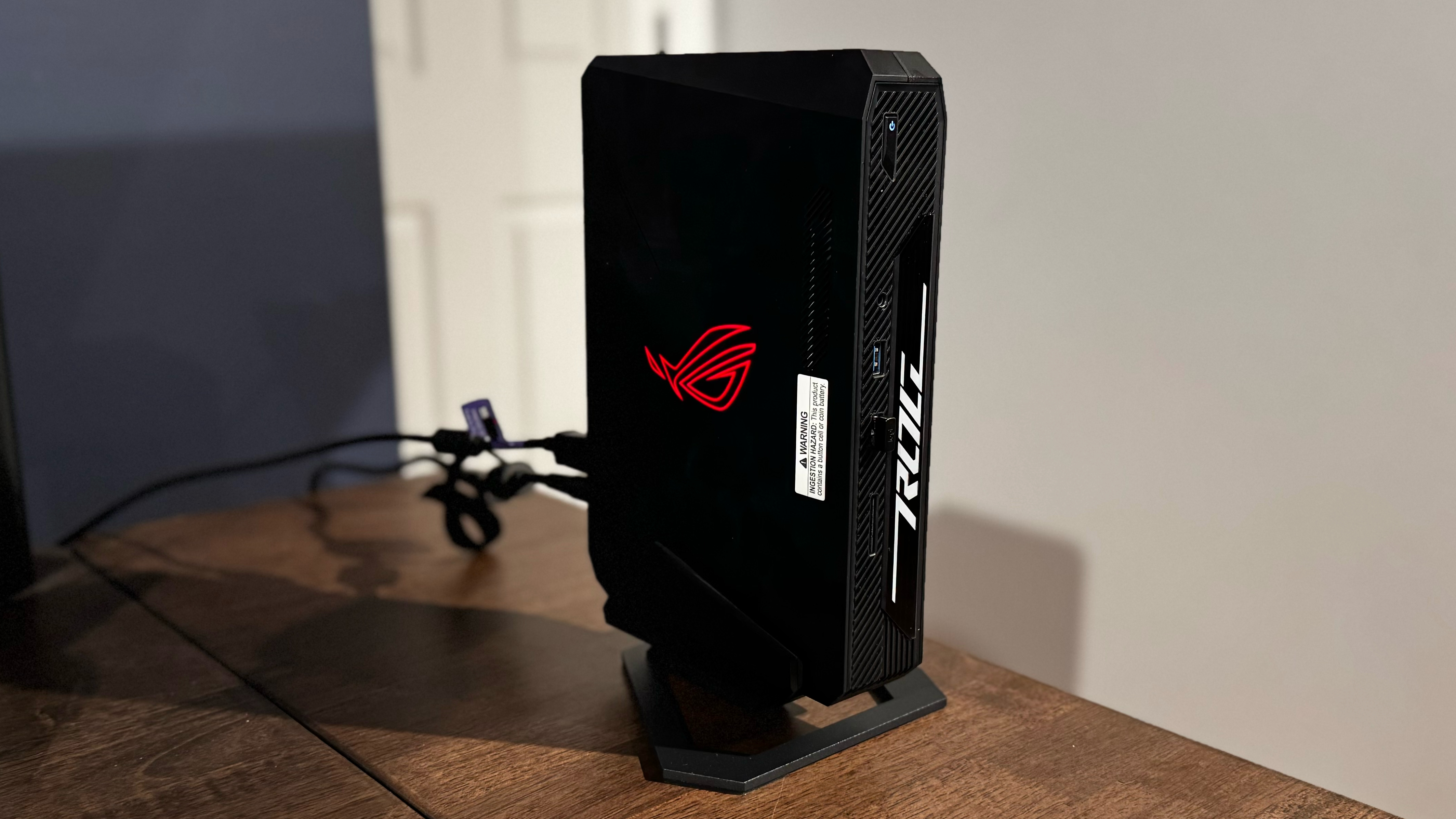
Compact size allows it to first nearly anywhere
Quiet operation
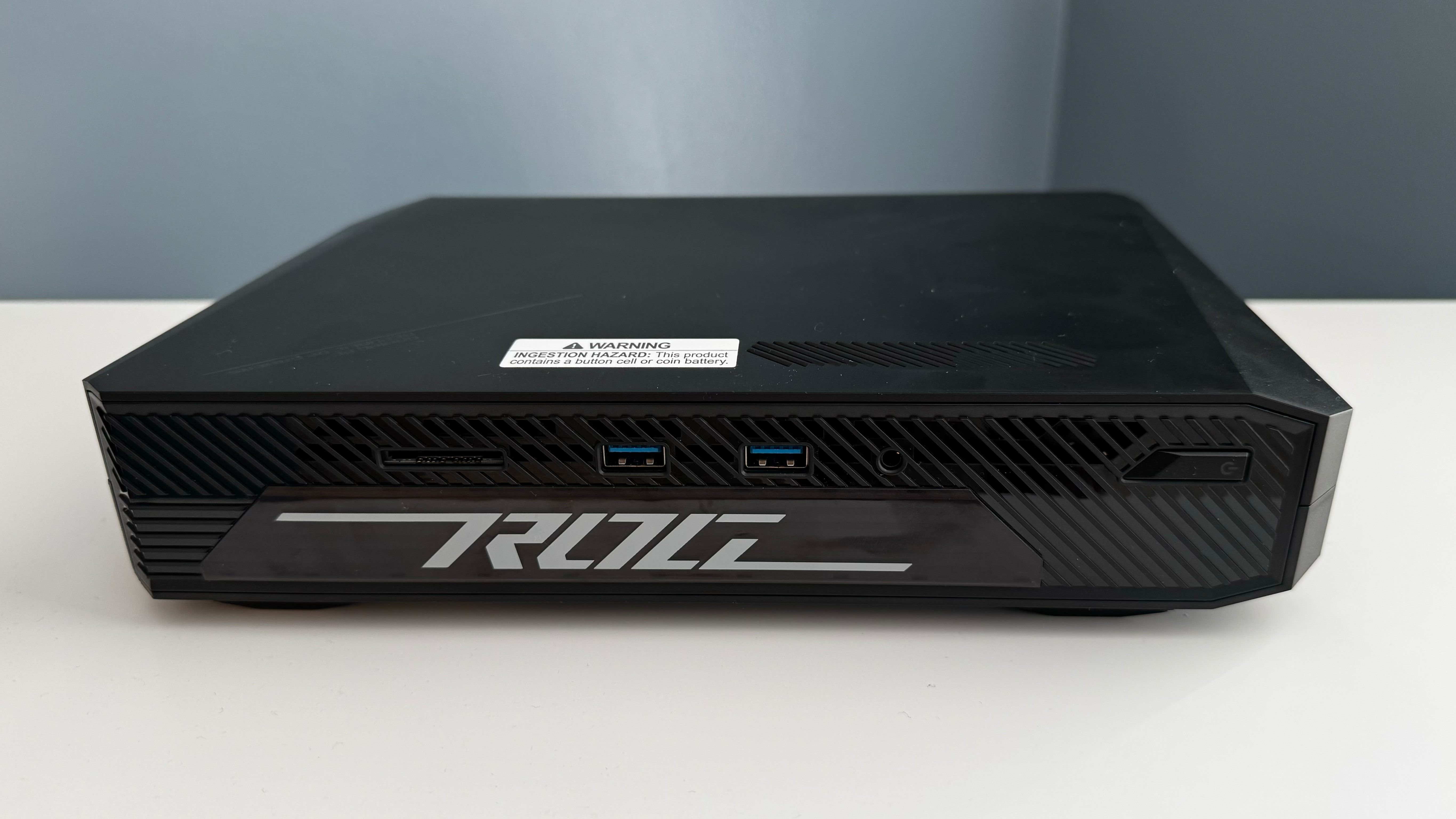
Pricey as tested ($2,199)
Could use a few more Thunderbolt 4/USB-C ports
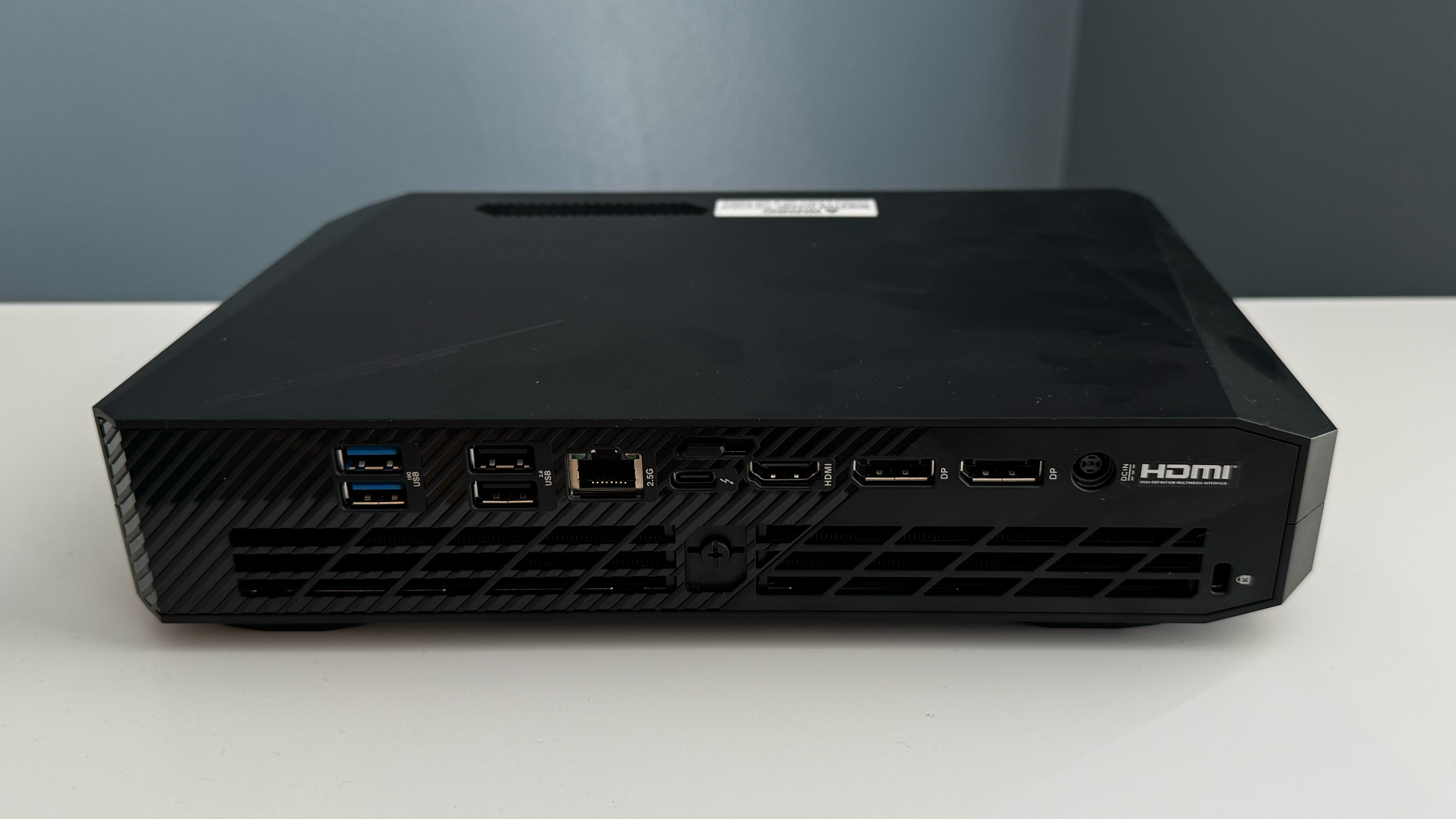
Internal hardware upgrades are limited to memory and storage
Why you’re able to trust Tom’s HardwareOur expert reviewers spend hours testing and comparing products and services so you can choose the best for you.Find out more about how we test.
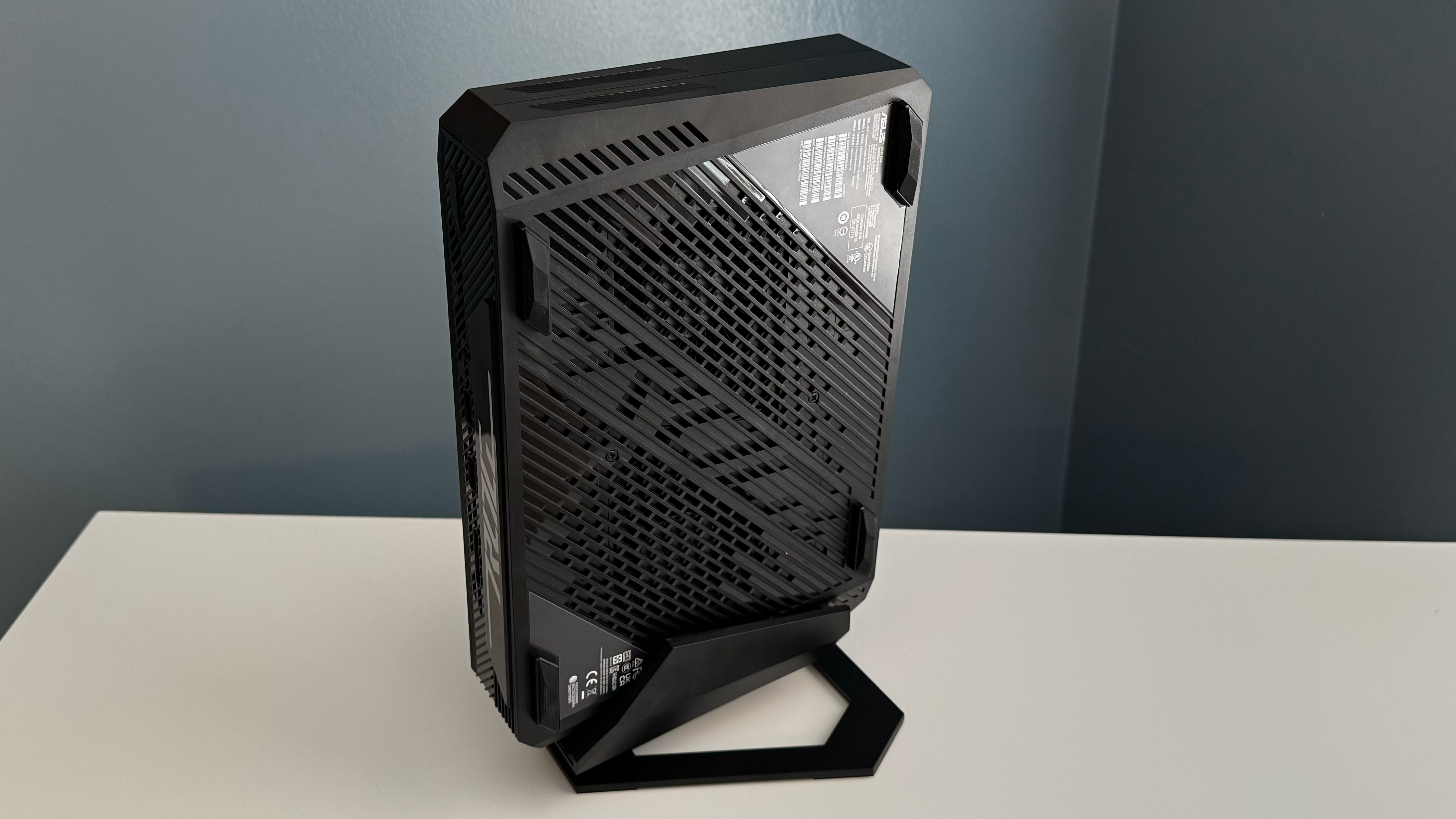
The NUC name used to be synonymous with Intel, but in July 2023, Intel decided toabandon the mini PCbusiness and laterlicensed the brand to Asus. Since then, Asus has released several new NUC PCs and has taken over the duties of supporting legacy Intel-branded units. To further expand the NUC lineup, Asus recently introduced its firstROG NUC mini gaming PC.
We tested a ROG NUC 970 review unit powered by an Intel Core Ultra 9 185H processor, 32GB of DDR5-5600 memory, and a 1TB SSD. Perhaps most importantly for gamers, the ROG NUC 970 features a laptop-sourced Nvidia GeForce RTX 4070, which seriously upgrades the available graphics power compared to NUCs with integrated graphics.
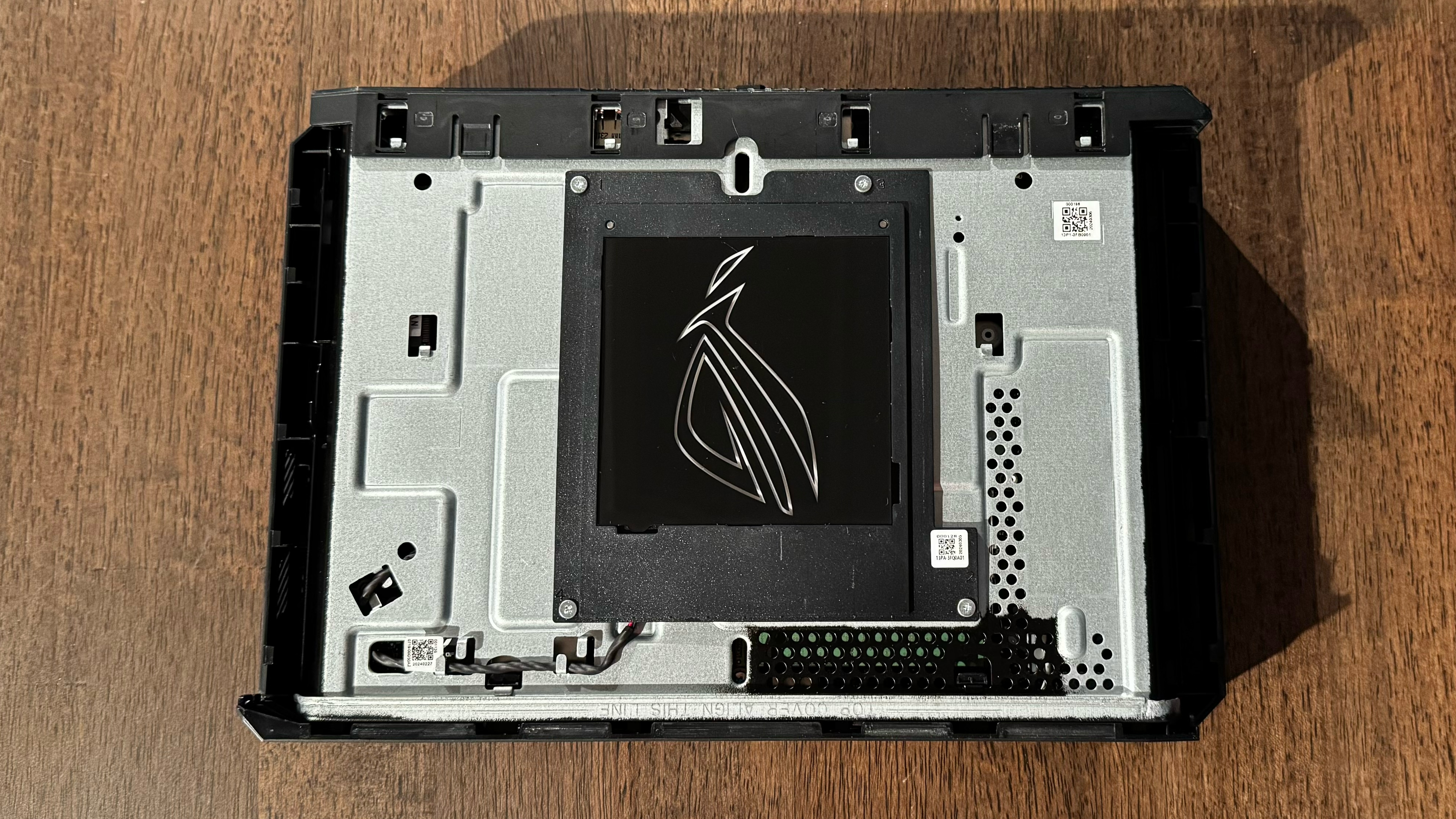
Asus ROG NUC 970 Specifications
Design of the Asus ROG NUC 970
The the ROG NUC 970’s chassis is primarily constructed of black plastic. It’s an unassuming box roughly the size of two large desktop-classWestern Digital EasyStoreexternal hard drives laid flat and placed side-by-side. The front of the chassis has diagonal lines going across it to give a bit of visual flair, and large “ROG” branding sits front and center.
The only way you know that the ROG NUC 970 is meant for gaming, besides the ROG placard up front, is the RGB ROG logo on the top of the chassis. I didn’t notice the logo at first because it is hidden from view unless you look very closely. However, I used the Armoury Crate software to enable the RGB element, choosing one of the eight available color patterns.
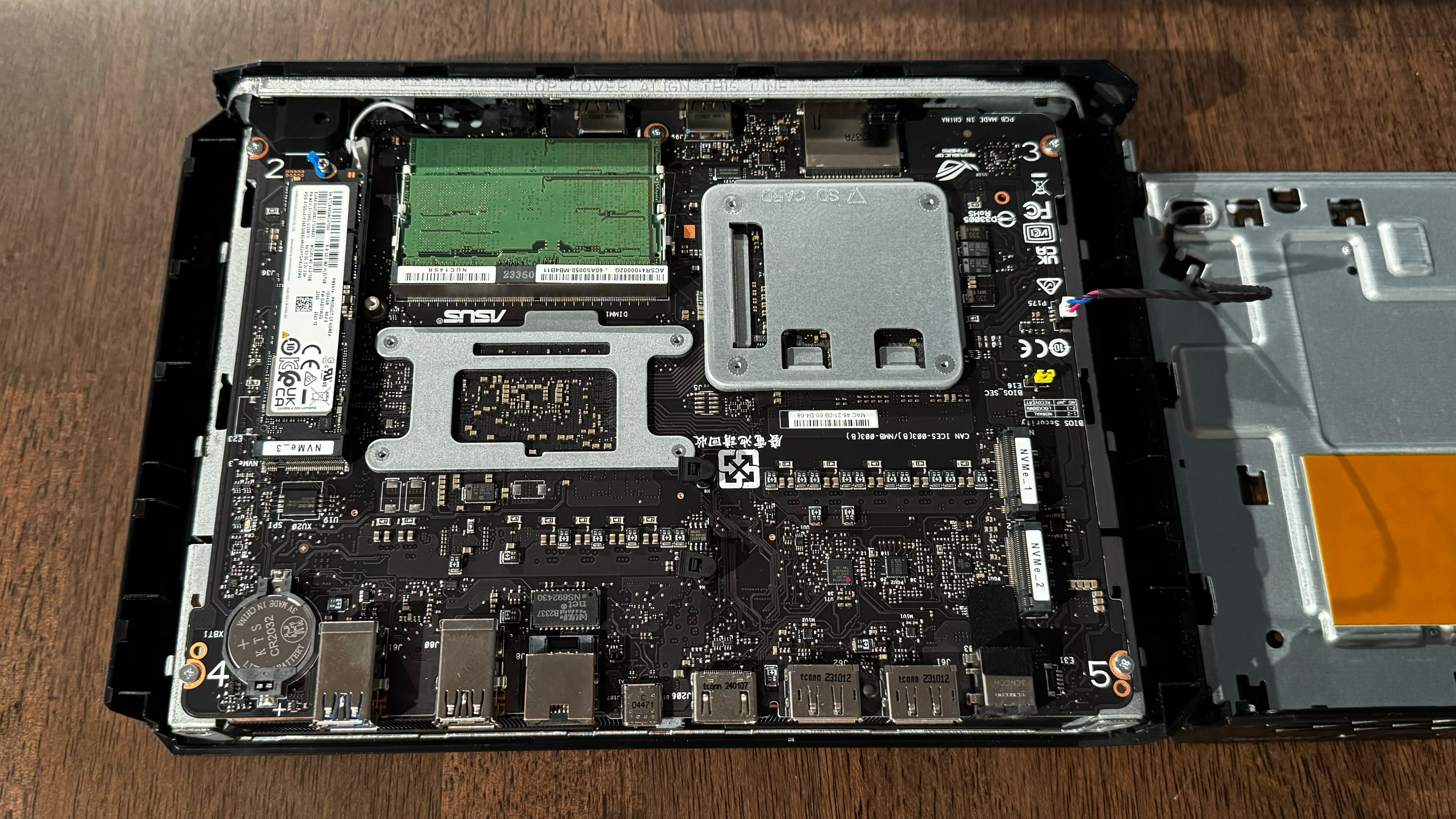
Asus packs a lot into this compact 2.5-liter chassis. While the unit is screwed together well, the materials used in the chassis aren’t up to par for a desktop system that costs over $2,000. You can place the ROG NUC 970 on your desk in one of two ways. The first option is to set it horizontally on your desk, where four rubber feet give it enough clearance for sufficient ventilation. Those feet also ensure the machine doesn’t slide around on your desk if accidentally nudged.
The second option is to use the included stand, which allows you to mount the ROG NUC 970 vertically. The stand uses a plastic cradle with rubberized padding so you don’t scratch the ROG NUC 970. The actual base of the stand is constructed of metal to add weight, providing a solid platform for ROG NUC 970.
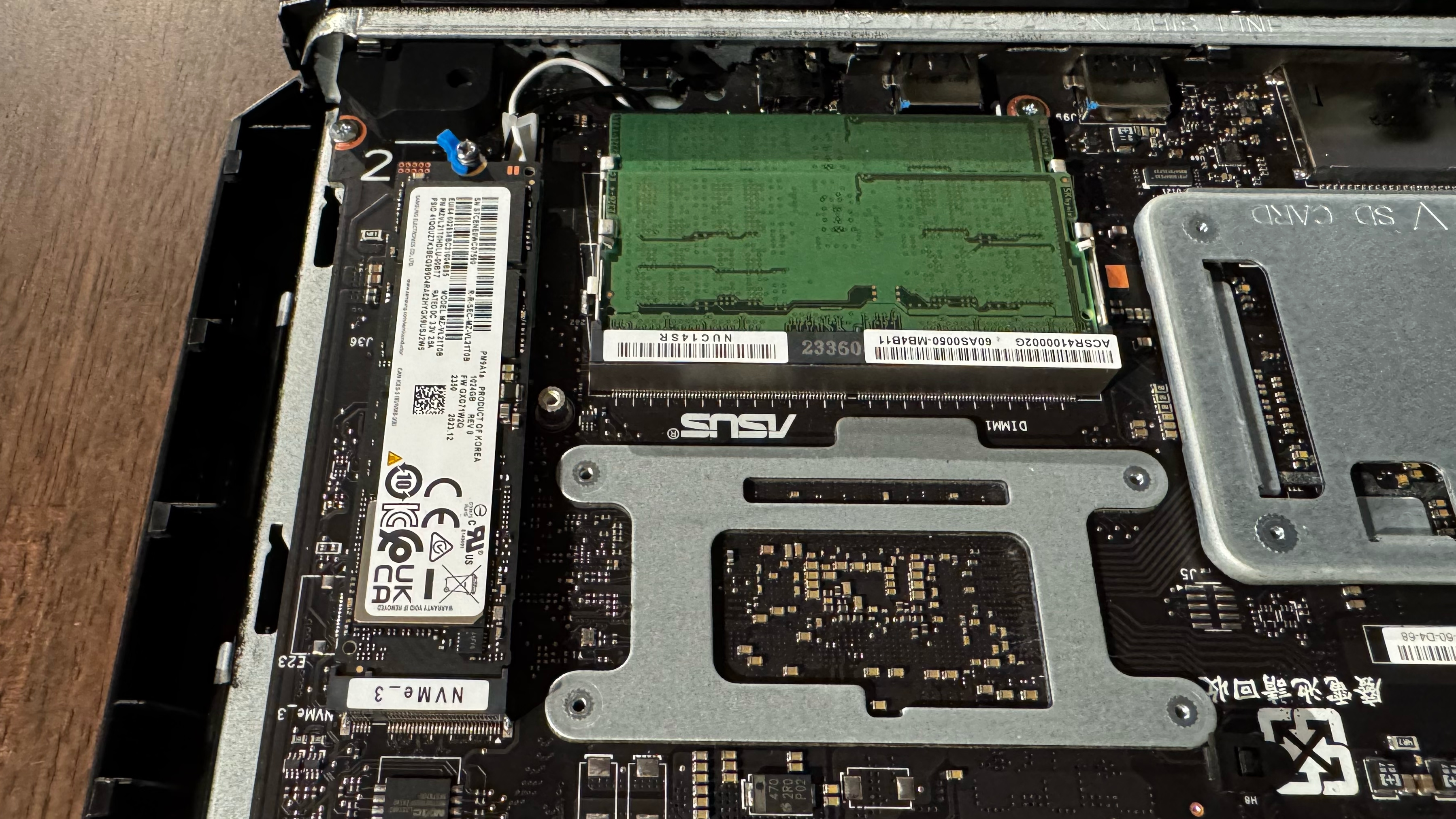
The ROG NUC 970 measures 10.62 x 7.08 x 1.97 inches and weighs 5.73 pounds.
Ports and Upgradeability on the Asus ROG NUC 970
You’ll find two USB 3.2 Gen2 Type-A ports, an SD Express reader, and a 3.5mm combo jack on the ROG NUC’s front panel. The power button is located on the far right of the front panel. However, most of the ports are on the back panel of the ROG NUC 970. There are four USB 3.2 Gen 2 Type-A, two USB 2.0 Type-A, one Thunderbolt 4, a 2.5 GbE jack, one HDMI, and two DisplayPort 1.4a ports. The assortment of ports is comprehensive, but I would have preferred one additional Thunderbolt 4 or a USB 4 port up front for easy access.
Even though this is a compact 2.5-liter PC, accessing the internals is relatively easy. There’s a small switch on the back of the chassis that you must unlatch. Then, the entire top half of the chassis slides off. With the top half removed, you’ll discover a metal panel where the RGB logo sits. A Phillips screw on the back of the chassis must be removed, which allows you to remove this metal panel. Only then can you access the upgradeable internal components.
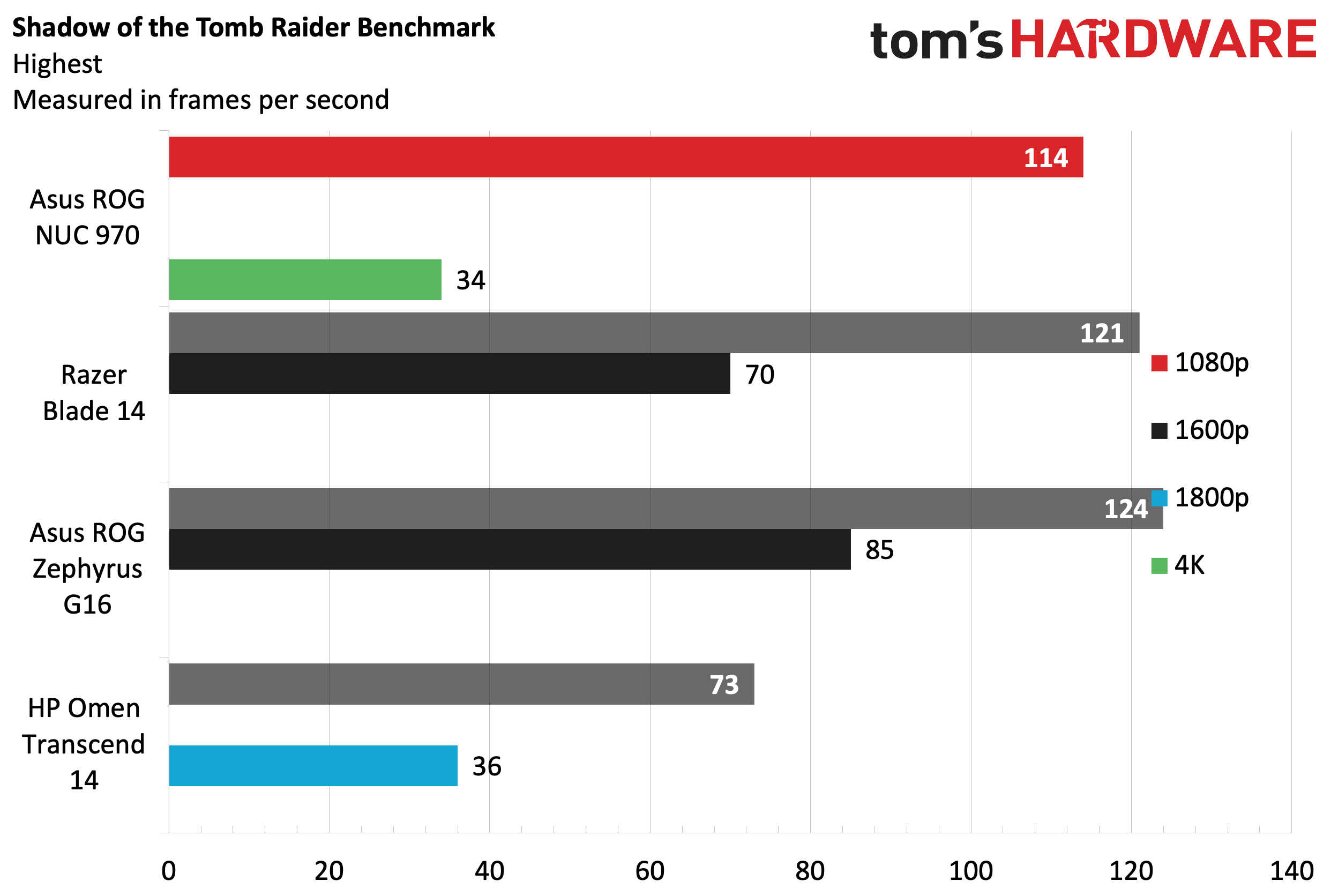
There are two memory slots, both of which were occupied by 16GB DDR5-5600 SO-DIMMs. Three M.2 slots are present for storage expansion, one of which was occupied by a Samsung PM9A1a PCIe 4.0 SSD.
There is no way to upgrade the CPU or GPU, which is to be expected. The ROG NUC 970 uses laptop parts, so even if they were user-accessible, finding a suitable upgrade or replacement would prove challenging.
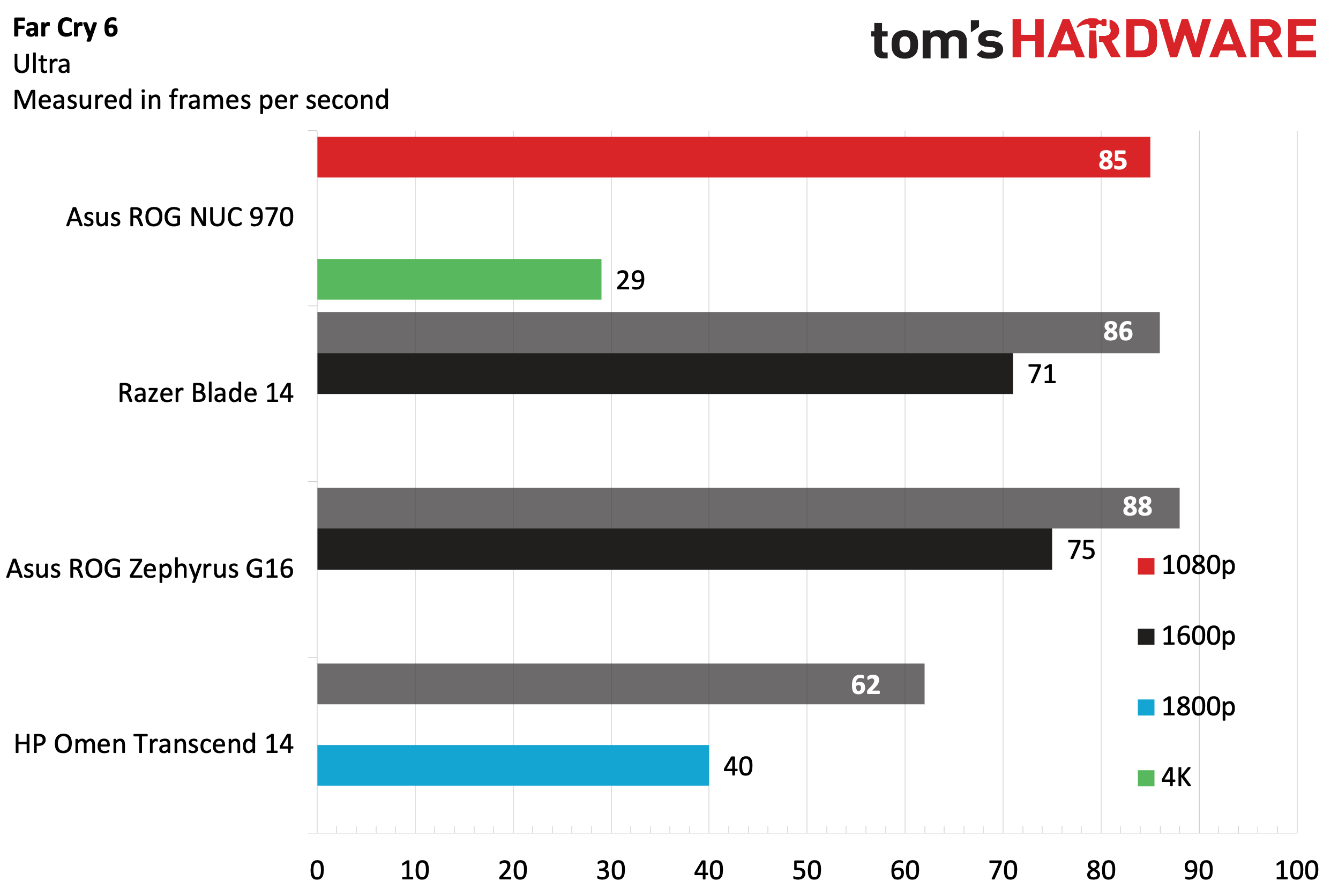
Gaming Performance on the Asus ROG NUC 970
The ROG NUC 970 isn’t your typical gaming desktop. Due to its compact size and thermal restrictions, it uses laptop components. That means that the processor (Intel Core Ultra 9 185H), GPU (Nvidia GeForce RTX 4070), and RAM (DDR5 SO-DIMMs) are more akin to what you’d find in a gaming laptop than a full-size gaming desktop. The GeForce laptop-based RTX 4070 used in the ROG NUC 970 is not directly comparable to the desktop-classRTX 4070you’d find in standard desktop machines.
Because of this the competitors that we have chosen for the ROG NUC 970 are laptops. Of course, they’re not directly comparable with respect to form factors, but the actual hardware powering the systems is a closer match. In this case, we’ve lined up theRazer Blade 14, which has an AMD Ryzen 9 8945HS processor, 32GB of DDR-5600 memory, and a GeForce RTX 4070. TheAsus ROG Zephyrus G16features an Intel Core Ultra 9 185H processor, 32GB DDR5-7467 memory, and a GeForce RTX 4090. Finally, we have theHP Omen Transcend 14, which is equipped with a Core Ultra 7 155H, 16GB of memory, and a GeForce RTX 4060.
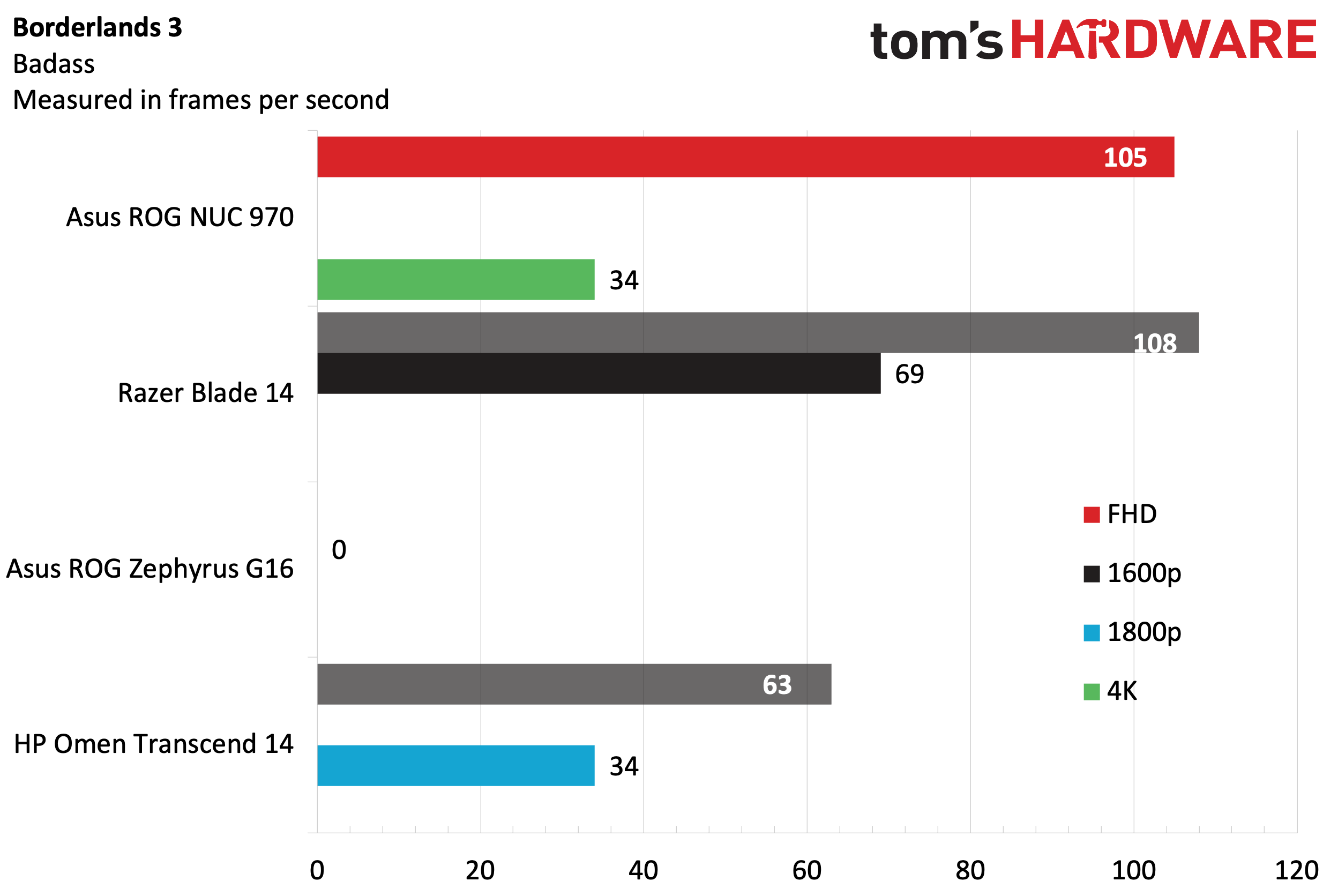
WithGrand Theft Auto 6coming out next year (I’m not holding my breath on that one), I’ve been honing my skills on the decade-oldGrand Theft Auto V. The game has long since shown its age, but Rockstar has done a lot to keep the actual gameplay fresh for returning gamers, including myself. I typically play games at 1440p resolution and saw performance of around 150 frames per second on Very High settings.
Our performance comparisons are at 1080p, as the comparison systems (which are laptops) support different resolutions on their displays. In our first benchmark,Shadow of the Tomb Raider(Highest setting), the ROG NUC 970 took third place at 114 frames per second (fps). The Razer Blade 14, which pairs its RTX 4070 with a Ryzen 9 8945HS processor, hit 121 fps, while the ROG Zephyrus G16 with its RTX 4090 took the crown at 124 fps.
Moving toCyberpunk 2077(Ray Tracing Ultra settings), the groupings were tighter, with the ROG NUC 970 again coming in third place (39 fps). However, the first-place Razer Blade 14 was only slightly ahead with 42 fps.
InFar Cry 6(Ultra settings), the top three competitors were again very competitive, with the ROG NUC 970 hitting 85 fps at 1080p. The Razer Blade 14 and ROG Zephyrus G16 were pretty close at 86 fps and 88 fps, respectively.
The Razer Blade 14 opened a sizeable lead over the ROG NUC 970 in the taxingRed Dead Redemption 2(Medium settings) benchmark, achieving 73 fps. The ROG NUC 970 settled for second place at 63 fps, while the ROG Zephyrus G16 had an uncharacteristic hiccup, hitting just 54 fps.
The ROG NUC 970 and Razer Blade 14 duked it out inBorderlands 3(Badass setting), with the latter having the slight advantage (108 fps versus 105 fps). The ROG Zephyrus G16 put up a big goose egg, as it couldn’t complete the benchmark without crashing.
We next moved to ourMetro Exodusstress test, using the RTX preset for 15 consecutive runs. The Core Ultra 9 185H processor averaged 4.357 GHz across the performance cores and 3 GHz across the efficiency cores. The chip package averaged 83 degrees Celsius (181.4 degrees Fahrenheit). During the test, the GPU averaged 2 GHz at a temperature of 62.81 C (145 F). The system fans were just barely audible in my otherwise quiet home office during the stress test.
Productivity Performance on the Asus ROG NUC 970
The first stop in our productivity suite is with the Geekbench 6 synthetic CPU benchmark. Despite featuring the same Core Ultra 9 185H processor, the ROG NUC 970 (2,341 points single-core, 13,514 points multi-core) fell roughly 10 percent in performance behind the ROG Zephyrus G16.
Our file transfer test involves shuffling 25GB worth of mixed media. During the test, the ROG NUC 970 completed the task at an average of 1,686.77 MBps, which placed it last, with the Razer Blade 14 leading the pack at 1,951,61 MBps.
The Handbrake test involves transcoding a 4K video to 1080p and recording the time needed to finish the task. The ROG NUC 970 finished in three minutes and 40 seconds, putting it 12 seconds ahead of the second-place ROG Zephyrus G16 (3:52). The Razer Blade 14 completed the benchmark in just over four minutes (4:01).
Asus ROG NUC 970 Configurations
The ROG NUC is available in two configurations. The base ROG NUC 760 system features an Intel Core Ultra 7 155H processor, 16GB of DDR5-5600, a 512GB SSD, and a GeForce RTX 4060 for $1,629.
Our ROG NUC 970 review unit, which has the Core Ultra 9 185H, 32GB of DDR5-5600, a 1TB SSD, and a GeForce RTX 4070, retails for $2,199.
As of this writing, neitherAsusnor retailers likeNewegghave the ROG NUC 970 in stock.
Software and Warranty on the Asus ROG NUC 970
Asus includes a decent number of third-party software add-ons for the ROG NUC 970. Three of its own utilities are included: Armoury Create, Aura Creator and Aura Wallpaper Creator. Armoury Crate is a utility for monitoring system vitals, adjusting system profiles, and managing RGB controls (among other things). But it’s also notorious in the enthusiast community for its ineptitude and bloat factor. I had to constantly fight with the utility just for it to perform updates for its various components.
Aura Creator allows you to create custom lighting effects and patterns to use with your systems and peripherals, while Aura Wallpaper Creator allows you to make colorful, dynamic wallpapers for your desktop.
Some Intel apps are included, like the Intel Graphics Command Center (for the IGP) and the Killer Intelligence Center (for configuring the onboard Killer 2.5 GbE controller). Finally, there’s the RealtekAudioConsole for adjusting sound profiles.
The ROG NUC 970 comes with a one-year manufacturer warranty.
Bottom Line
The Asus ROG NUC 970 includes gaming laptop-grade hardware repurposed in a compact desktop PC form factor. This approach has pluses and minuses. The good news is that you get a power-efficient PC that takes up minimal space on your desk while still giving adequate performance for 1080p and 1440p gaming. The downside is that you pay a premium for the compact size, and your hardware upgrade options are more limited compared to a traditional desktop PC.
That said, the Asus ROG NUC 970 mostly performed as expected against laptops with comparable hardware (Core Ultra 9 185H and RTX 4070) and did so while delivering far lower fan noise than laptops when under heavy load. The chassis is attractive, albeit the materials used could be better given the price tag. Asus offers many USB-A ports and even an SD card reader, but I would have liked to have seen at least one additional Thunderbolt 4 or USB 4 port.
However, many customers will be stymied by the price. Yes, you get a compact chassis, but it offers similar performance to an entry-level budget “mid-tower” gaming PC like theCyberPowerPC Gamer Xtreme, which retails for $1,200. Is the $1,000 price difference worth some reclaimed space on or under your desk? You be the judge!
Brandon Hill is a senior editor at Tom’s Hardware. He has written about PC and Mac tech since the late 1990s with bylines at AnandTech, DailyTech, and Hot Hardware. When he is not consuming copious amounts of tech news, he can be found enjoying the NC mountains or the beach with his wife and two sons.